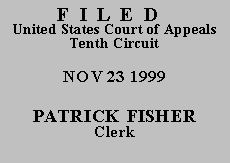

| REX LAIN,
v.
STATE OF WYOMING |
No. 99-8064
(D.C. No. 98-CV-134) |
Lain was charged with first degree murder, based on the killing of John Harding. Lain and his friend Scott Young drove out of town one night with Harding. Young beat Harding senseless, and Lain helped him hide the apparently lifeless body. When Harding began to stir, Young, according to Lain, stabbed him to death. Lain denies stabbing Harding himself, although the state was prepared to present Young's testimony to the contrary. Against this backdrop, Lain pleaded guilty to voluntary manslaughter, all the while denying that he personally stabbed the victim. The state court accepted Lain's plea, finding that there was a factual basis to the charge of being an accessory before the fact to voluntary manslaughter.
As an initial matter, we must determine whether Lain has met the jurisdictional prerequisite of a timely notice of appeal. The district court issued a detailed order on May 20, 1999, granting Wyoming's motion to dismiss Lain's habeas petition. However, it did not enter a judgment on a separate document as required by Fed. R. Civ. P. 58. An order containing reasoning and legal analysis does not generally constitute such a separate document sufficient to trigger the appeal process. See Clough v. Rush, 959 F.2d 182, 185 (10th Cir. 1992). The May 20, 1999, order clearly contains reasoning and analysis. Therefore, although it would appear from the district court docket sheet that Lain did not file his notice of appeal until July 13, 1999, more than 30 days after the district court issued its order, see Fed. R. App. P. 4, we conclude that his notice of appeal is nevertheless timely because the May 20, 1999, order was not accompanied by a separate Rule 58 judgment so as to trigger the appeal process.
For us to review Lain's appeal, however, he must first obtain a certificate of appealability, pursuant to 28 U.S.C. § 2253(c)(1)(A), by making "a substantial showing of the denial of a constitutional right," 28 U.S.C. § 2253(c)(2). The State argues that the calculation of the statutory limitation period never implicates the federal constitution and therefore cannot present an issue justifying the grant of a certificate of appealability. We disagree. We have held that "[t]here may be circumstances where the limitation period at least raises serious constitutional questions and possibly renders the habeas remedy inadequate and ineffective." Miller v. Marr, 141 F.3d 976, 978 (10th Cir. 1998). To avoid such constitutional questions, we may subject the AEDPA limitations period, which is procedural and not jurisdictional, to equitable tolling in appropriate circumstances. See id. One such circumstance is when the petitioner asserts "that a constitutional violation has resulted in the conviction of one who is actually innocent or incompetent." Id. (citing Schlup v. Delo, 513 U.S. 298, 324-29 (1995); Cooper v. Oklahoma, 517 U.S. 348, 352-56 (1996)). Therefore, the question of whether equitable tolling should apply to a facially untimely habeas petition may raise substantial constitutional questions compelling the grant of a certificate of appealability. Such, however, is not the case here.
Lain does not contest the district court's calculation of the AEDPA limitation period or its application of the statutory tolling provisions contained in 28 U.S.C. § 2244(d)(2). Rather, he simply argues the district court erred in rejecting his substantive claims. Under the principle of liberal construction of pro se pleadings, we interpret this as a request to invoke a fundamental miscarriage of justice argument for equitable tolling. See Schlup, 513 U.S. at 314-17; Miller, 141 F.3d at 978.
Lain, however, does not maintain that he was actually innocent. He argues instead that his actions in driving out of town with Young and Harding and in hiding the body amounted at most to participation as an accessory after the fact, rather than before the fact. Moreover, Lain presents no convincing argument that the district court was incorrect in finding Lain's claim of constitutional error--that his guilty plea was involuntary because he lacked notice of the elements of the charge--to be both procedurally barred and without merit. See Henderson v. Morgan, 426 U.S. 637, 647 (1976). Therefore, Lain's claims do not amount to "a substantial showing of the denial of a constitutional right," 28 U.S.C. § 2253(c)(2), and we deny his request for a certificate of appealability.
Lain's motion to proceed in forma pauperis is GRANTED; the application for a certificate of appealability is DENIED; this matter is DISMISSED.
The mandate shall issue forthwith.
ENTERED FOR THE COURT
Carlos F. Lucero
Circuit Judge
*.The case is unanimously ordered submitted without oral argument pursuant to Fed. R. App. P. 34(a)(2) and 10th Cir. R. 34.1(G). This order and judgment is not binding precedent, except under the doctrines of law of the case, res judicata, and collateral estoppel. The court generally disfavors the citation of orders and judgments; nevertheless, an order and judgment may be cited under the terms and conditions of 10th Cir. R. 36.3.